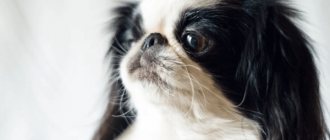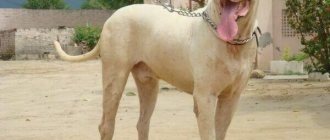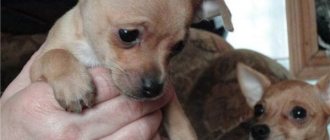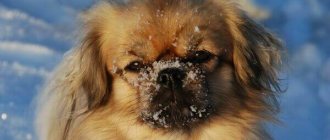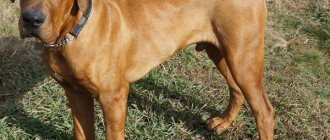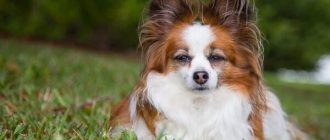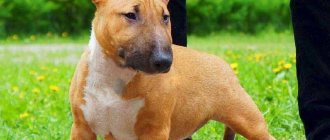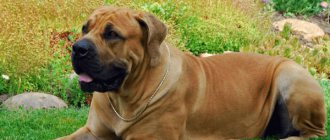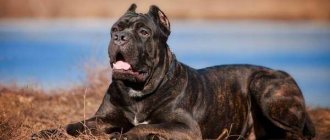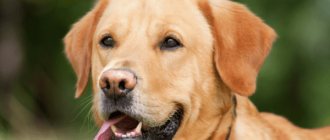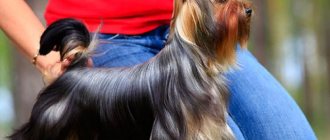Mastiffs are a fairly large group of breeds, united by a common name and some similar characteristics.
It includes, for example, such breeds as the Spanish Mastiff, Tibetan, French, Major, Argentine, Neapolitan and others.
Bullmastiffs are a breed of dog developed in England by crossing English Bulldogs and English Mastiffs. The purpose of their creation was to obtain animals capable of protecting people and their homes.
The first breeders were gamekeepers who fought against poachers and needed strong and courageous helpers, which is why bullmastiffs were called “night dogs of gamekeepers.”
At first, the huntsmen used English bulldogs, which had good grip, but were too short for this work, then English mastiffs, which were not agile and fast enough.
So it was decided to cross these breeds to get one with their best traits.
The puppies born as a result of such matings fully met the expectations of the breeders: they were large, fast, powerful, had an excellent grip and had a keen sense of smell and sensitive hearing.
The improved characteristics of these dogs allowed them to quickly gain popularity not only in England, but also in other European countries, as well as in America and Australia.
Over time, it was no longer enough for breeders to only cross the two breeds and they decided to create new, purebred dogs that had 60% of the qualities of bulldogs and 40% of mastiffs. So at the beginning of the 20th century. Bullmastiffs appeared.
In 1924, this breed was recognized by the English Kennel Club, and in 1933 by the American Club.
Description of the breed and what it looks like in the photo
Bullmastiffs are strong, powerful and muscular dogs..
At the same time, they are distinguished by agility, speed, a harmonious, toned physique and smooth, springy movements.
Breed standard:
- The chest is wide, the ribs are rounded;
- the paws are straight, with well-developed muscles, not too long, the pads are rounded, large, the claws are dark;
- the back is wide, straight, shortened;
- the tail is long, set high, tapering towards the end;
- the head is square, large, with pronounced skin folds on the forehead;
- the nose is wide, dark;
- the muzzle is not pointed, large;
- the ears are small, triangular in shape, set high;
- the eyes are set wide apart, the iris is brown or hazel;
- The teeth are large, the bite is straight.
The coat of Bullmastiffs is dense, short, and fits tightly to the body.
General form
Males have prominent muscles, and females have refined shapes. Dogs vary in weight and height.
The height of the “boy” at the withers is almost seventy centimeters, the knots are five to nine centimeters lower.
The weight of a bullmastiff of the stronger sex is up to sixty kilograms, while “girls” weigh at least ten kilograms less.
The dogs have a melancholic look, as if slightly tired. But this is nothing more than a trick - the dog is always on the alert and ready to repel any attack from strangers.
Pet Personality
Bullmastiffs, which outwardly look menacing and intimidating, are actually good-natured, affectionate, unobtrusive dogs, loyal to the owner and all family members.
To this day they can be used as a reliable guard, but more often they are acquired as faithful companions and companions.
Representatives of this breed easily adapt to the owner’s lifestyle and are equally happy to accompany him on morning runs or simply lie next to him while he watches TV.
These dogs love both active walks with games and exercise, and leisurely walking..
Bullmastiffs are fearless and, despite the lack of aggression towards people, will not hesitate to defend their family if they sense impending danger. But you shouldn’t expect them to protect things and property - they won’t do this without a command.
They get along well with children, whom they perceive as the main object of protection . Dogs are kind and caring towards children, tolerate all their pranks and protect them from offenders.
There are often cases where dogs do not allow even parents to approach guilty children if they want to punish them.
Bullmastiffs are smart and quick-witted, they remember commands well and never act relying on emotions and without assessing the situation.
Cowardice and aggression are considered a breed defect; such individuals are not allowed to participate in exhibitions or breed..
Expert opinion
Kozhevin Semyon Kirillovich
Expert dog handler.
The reserved character and balanced psyche allow bullmastiffs to easily adapt to any conditions. Representatives of this breed do not strive to take a leadership position, despite their tendency to dominate, but only if they see the owner as a leader. These dogs need early socialization and proper education - this is the only way they will learn to obey their owner unquestioningly. Beginning dog breeders may need to undergo the OKD and ZKS.
History of the origin of the bullmastiff breed
The Bullmastiff breed is quite young, bred at the end of the 18th century in England. At first it was called the "night huntsman's dog." These dogs were used to protect forests and estates from poachers and robbers. The breeders sought to obtain a strong, vigilant guard and assistant for gamekeepers.
The dog had to track down the intruder, and then catch up and detain him until the owner arrived. Therefore, they paid attention to such qualities as patience, a sensitive sense of smell, malice, and a strong grip. At first, Old English Bulldogs were used for this, but they were very small. Mastiffs were not suitable for this work due to their slowness.
Therefore, huntsmen began to crossbreed dogs of these breeds. At first, breeding was carried out by amateurs. Only at the end of the 19th century did professional breeders become interested in the breed. They began to improve the appearance and working qualities of these dogs. St. Bernards, Bloodhounds, and Great Danes were also used in breeding. Representatives of the breed have become faster, stronger and less aggressive. But officially the Old English Bulldogs and Mastiffs are considered the ancestors of Bullmastiffs.
The breed was recognized only in the 20s of the 20th century. The dogs began to be exported to other countries, where they quickly became popular. The breed was called the Bullmastiff, and a standard was created in 1935. These dogs began to be used in the police and army. To this day, bullmastiffs guard diamond mines in South Africa. In the second half of the 20th century, these dogs were increasingly adopted as companions. They are valued for their endurance, devotion, and calm temperament.
Bullmastiff dogs appeared in Russia only in the late 80s of the 20th century. They quickly became popular, by the end of the century the number of animals had increased, and they began to participate in international exhibitions. Although some still consider bullmastiffs to be dangerous fighting dogs.
Advantages and disadvantages
Bullmastiffs are loyal and good-natured companion dogs with a number of advantages, including:
- good guard and security qualities;
- love for children;
- no need for great physical activity;
- Possibility of living in an apartment;
- intelligence and learning ability;
- lack of specific odor;
- balanced character;
- easy care.
Among the disadvantages of the breed can be noted:
- increased salivation;
- snore;
- stubbornness;
- short life expectancy;
- intolerance of male dogs towards other dogs of the same sex.
Also, these dogs shed quite heavily, which can cause inconvenience, especially when kept in apartments.
Mating
Bullmastiffs are a breed whose puppies will not provide commercial profit. Raising a dog requires you to spend much more than it is worth. There are both pros and cons of mating. If both dogs are famous, have suitable characteristics and the conditions for keeping the puppies are ideal, then you can safely untie them. Otherwise, mating will be useless, especially if there is no demand for the breed.
Puberty occurs at 18-20 months. The bitch is bred on her third heat (13-15 days from the beginning). The signs are:
- Swollen loop;
- The discharge is light and translucent;
- The girl invites by moving her tail, hips, and spreading her paws wide.
Animals are checked for diseases and cleared of parasites within 2 weeks. It is important to choose dogs that complement each other (deficiencies are corrected, good qualities are enhanced). For the first time, you can invite a specialist.
Pets are walked together. The act must take place on the territory of the dog, subject to the availability of free space. The process itself may take from 5 to 20 minutes, and there may not be a lock. Repeated mating is scheduled after 2 days.
Care
Regular hygiene procedures are necessary for representatives of this breed - they help maintain an attractive appearance and maintain the health of pets.
Bullmastiffs do not require complex care, but they must be taught hygiene from early childhood, otherwise it will be impossible to cope with an adult and disobedient dog..
Wool and bathing
The coat should be brushed with a natural bristle brush 2-3 times a week, and daily during shedding . This will help improve the dog's blood circulation and get rid of dust and dead hair.
After each walk, you need to wash your paws, and carefully inspect the pads and rub vegetable oil into them to avoid the formation of cracks. Also, after walking and eating, you need to wipe your pet’s face with a towel.
NOTE!
Bullmastiffs should be completely bathed as they become dirty, but not more than once every 3-4 months, using shampoo and conditioner intended for short-haired dogs.
Ears
Inspect and wipe weekly with a cotton pad soaked in warm boiled water, removing dust and dirt accumulated in the inside.
If there is an unpleasant smell from the ears, redness, excess wax or black plaque, you should take your dog to the veterinarian.
Claws
If the claws do not grind down on their own, they need to be trimmed monthly with a nail clipper and the sharp edges smoothed with a nail file.
If the claws are very hard, the paws must first be kept in warm water for several minutes.
Eyes
Inspect and wipe daily with a soft, lint-free cloth, removing any gray lumps that have appeared overnight.
Healthy eyes should be shiny, without redness or souring.
Teeth
To prevent the formation of plaque and tartar, you need to add solid food to your pet’s diet and brush his teeth 3-4 times a week using a special brush and toothpaste for dogs.
Walk
Bullmastiffs need regular long walks, moderate exercise and play . Representatives of this breed need to be walked at least twice a day for 1-2 hours.
Socialization
Bullmastiff dogs are suitable for families with children and single people. They know how to adapt to the pace of life of their owners. But dogs are not recommended for older people and athletes. The former will not be able to cope with powerful, sometimes stubborn pets. But long hours of jogging and hiking are not for these phlegmatic giants.
English Bullmastiff and children over 10 years old get along well. The dog loves to play with the guys, provided that they know how to treat their four-legged friend. It is not recommended to leave children alone with a pet. He is patient and forgiving. But there is a problem - the large size of the pet: it can accidentally touch, push or crush the child.
The English guard is indifferent to friends and family acquaintances. True, he will not let the guests out of his sight - in case they want to offend the family. But strangers should not be familiar with the dog - it will perceive it as a threat.
The English Bullmastiff lives in perfect harmony with other pets. He has weak hunting instincts: the aristocratic Englishman does not chase cats, and is indifferent to birds, rodents and reptiles.
Relationships with relatives develop differently. English Bullmastiff males are aggressive towards each other and every day they arrange showdowns called “who is the boss of the house.” Pets get along better with other breeds and females.
Life expectancy and major diseases
Bullmastiffs are strong and resilient dogs with strong immunity, however, they also have a tendency to develop a number of diseases.
Most often these dogs are diagnosed:
- dysplasia of the hip and elbow joints;
- congenital dislocation of the elbow;
- rupture of the cranial cruciate ligament;
- volvulus;
- interdigital dermatitis;
- lymphoma;
- urolithiasis;
- contact dermatitis;
- eczema;
- partial loss of hair;
- inversion and inversion of the eyelid;
- allergic reactions;
- hypothyroidism;
- obstructive cardiomyopathy.
On average, representatives of this breed live 8-10 years, but there are cases when bullmastiffs lived up to 12 years.
Interesting Facts
- The bullmastiff was used to guard diamond mines.
- John D. Rockefeller entrusted a dog of this breed with guarding his New York estate.
- In the mid-20th century, the British used dogs to suppress the uprising of the Mau Mau tribe in Kenya.
- The dog, named Gunner, played the role of the live mascot of the Arsenal football club for many years. Before each game, the dog was taken out onto the field and shown to the fans.
- Representatives of the breed have a very high pain threshold, so it is difficult to determine whether the dog is injured or not.
- Bullmastiffs are big fans of lying in an embrace with their owner on the sofa.
- Dogs can easily tolerate loneliness, which is very important for families in which all adults are busy at work. But puppies need someone to take them for an afternoon walk.
- Dogs do not tolerate heat and humid weather well. On such unfavorable days for them, bullmastiffs should be kept in an apartment.
What to feed?
Both natural products and industrial food are suitable for feeding bullmastiffs - the owner decides what exactly to feed the pet.
It is only necessary to ensure that the diet is balanced and contains everything necessary for healthy growth of the dog.
The natural menu should consist of:
- lean meat with cartilage and veins;
- greens, vegetables and fruits;
- oatmeal, rice, buckwheat;
- sea fish;
- fermented milk products;
- offal.
You should also include 1 tsp vegetable oils in your diet. per day and a vitamin-mineral complex.
You can't feed your pet:
- fatty meat;
- tubular bones;
- smoked meats, pickles, marinades;
- sweets and chocolate;
- legumes;
- cabbage;
- potatoes;
- bakery and pasta products;
- river fish.
When choosing industrial food, you should buy at least premium class products intended for large breed dogs. It is better to choose holistic food containing a maximum of meat.
IMPORTANT!
Among experienced breeders, the brands Bosch, Guabi, Go, Royal Canin, Brit, Acana, and Purina ProPlan are popular.
You cannot mix 2 types of nutrition, this can lead to problems with the gastrointestinal tract.
How many times a day and in what portions
The number of feedings depends on the age of the dog:
- 2-3 months – 6 times a day;
- 3-4 months – 4-5 times;
- 5-10 months – 3 times;
- from 10 months and older – 2 times.
The daily food intake for a puppy should be approximately 6% of its body weight, for an adult dog - 4%.
So, a dog weighing 50 kg eats about 2 kg of food per day, of which 60% is protein, 20% is cereals, 20% is vegetables and fruits.
Upbringing
Bullmastiff puppies take a long time to mature psychologically. Even a 3-year-old English bodyguard behaves like a silly little kitten or a junior. This is a breed trait, so you will have to be patient.
Basic principles of raising the Bullmastiff breed:
- no training for up to six months - this time is allocated to raising the puppy, explaining norms of behavior, socialization;
- from 7-8 months they undergo a general training course (OCD);
- after 2 years, special classes are shown - protective guard service (PSS), search and rescue service (PSS);
- Among sports disciplines, canicross, fetching, and dogpulling are suitable.
The characteristics of the breed include some willfulness, but not stubbornness. English Bullmastiffs are serious in their studies, study diligently and steadfastly endure monotonous repetitions of commands. However, breaks and game lessons are not superfluous.
Take into account that the pet is slow. Plus, he needs to comprehend each command and learn everything about it: why it is needed, what will happen if it is executed, what is the best way to do it, and whether it is necessary to do it at all, etc. He can spend a long time in such thoughts until the owner distracts his attention or switches to another activity.
The English Bullmastiff needs an owner with a strong character, great willpower and great patience. It’s not the dog’s stupidity that’s annoying – the breed is very smart. The majority of owners are nervous because of the slowness. If a person is choleric, it is better for him to choose another dog.
How to choose?
Before buying a puppy, you need to inspect the conditions of its detention and find out about the health of the parents - there are a number of pathologies that are inherited.
In a healthy, standard puppy:
- smooth, shiny coat without dandruff;
- proportional body with developed muscles;
- long tail that reaches the hock joint;
- straight paws with a U-shaped set;
- rounded ribs;
- wide muzzle;
- moist, shiny nose;
- straight bite;
- straight back, strong neck;
- eyes are dark blue or brown.
A properly developing puppy should weigh 9-10 kg at 2 months, at least 17 kg at 3 months.
It should be remembered that males look more textured, but are distinguished by a more independent character and a tendency to dominate. They are also more likely to experience allergic reactions and dermatitis.
Bitches are less expressive in appearance, but they are more sociable, easier to train and more tolerant of children..
Standard
When describing the Bullmastiff breed, the main attention is paid to:
- head;
- teeth and jaws;
- nose and lips;
- paws;
- neck;
- eyes;
- body;
- tail;
- wool;
- color of the animal.
Let's consider what standard requirements these parts of the dog's body must meet.
Price range
The cost of puppies is not fixed and depends on a number of factors: the titles of the parents, the place of purchase, as well as the age, gender and class of the future pet.
On average, the price of bullmastiffs varies from 10 to 50 thousand rubles.
You can buy a puppy at the market or through an advertisement cheaper than in kennels, but in this case the risk of purchasing a dog that is not purebred or has physical or psychological disabilities increases.
Color
Dog handlers distinguish two categories of colors for this breed - one-color and two-color.
In the first group, any shades must be uniform. Small white spots on the chest are allowed. The black “mask” near the tip of the muzzle has a deep color that gradually “blurs” in areas near the eyes.
The second category is divided into two subtypes: two-color and multi-color colors.
The color of two colors involves solid coloring with the presence of white or dark spots.
In the multi-color version, the spots are located in certain places and have different shades.
Prevention
An annual visit to the veterinarian is required. Conduct a full examination of the dog to identify diseases or abnormalities.
What to teach a bullmastiff puppy at home
- Accustoming to a nickname. It is important that the bullmastiff puppy associates the nickname with something pleasant. Give him his name and immediately give him his favorite treat or game.
- Accustoming to the place. The place should also evoke only pleasant associations; under no circumstances scold or punish the bullmastiff puppy when he is in his place. It is important that the place is located where no one will disturb the dog (for example, you should not place a bed on a hike) or in a draft.
- Teach your Bullmastiff puppy to greet you on all fours. It is unlikely that you will be pleased when a huge dog jumps on you, expressing delight. While your baby is jumping, turn away. Once all four paws are on the floor, squat down and pet him. It is important not to bend over the puppy, but rather to squat - this way he will be less tempted to start jumping again.
- Teaching a Bullmastiff puppy to be clean. As soon as the puppy is ready to do his business (usually shortly after sleeping and eating), take him outside. If he managed to go to the toilet outside, praise him and give him a treat. But don’t demand too much - a small puppy is not able to tolerate it, so there will be puddles and piles at home. Don't scold the puppy for them.
- Gradually teach your Bullmastiff puppy basic commands. The puppy’s entire training takes place through play, and every success is reinforced with a treat. Classes should under no circumstances cause negativity in the child.
- Teach your bullmastiff puppy to play healthy games. An important rule is that the game ends on your initiative before the baby gets tired or overexcited.
- Accustoming to a collar (harness) and leash. First introduce the puppy to new objects, and only then put the equipment on him. The time spent in a collar or harness increases gradually. At first, a couple of seconds is enough. If the puppy is restless and tries to get free, distract him.
- Getting to know different places, sounds, smells, people and animals.
Remember that every day, no matter how busy you are, your Bullmastiff puppy needs attention.
When raising and training a Bullmastiff puppy, it is important to find the right motivation that suits your dog. This could be, for example, a treat, play or stroking.
From 6 to 7 months, you can begin special training for a bullmastiff puppy (for example, start training OKD).
Training
Bullmastiffs have a high level of learning ability, they respond well to training, and master commands without extra effort.
During education, you cannot use harsh measures, otherwise the person being educated will show the strength of his stubbornness instead of success. To control a dog, you will need a firm but aggressive character. From a young age, the puppy must be made to understand who is the boss. To do this, for any daring act, take the dog by the scruff of the neck, lift it into the air, then carefully lower it to the ground and press it a little. After several similar repetitions, the pet will understand who the leader is.
The real training begins after the puppy reaches six months of age. There is no point in starting earlier due to the late development of bullmastiffs. Until this age, the pace of education is set and taught to the basic functions (toilet, allowed, not allowed, walks, etc.). They are trained from the very first day the dog appears in the house, showing patience, care and love. Aggression and biting should not be encouraged, even if they occur in a playful manner. Also during this period, socialization is carried out, introducing the pet to new people, taking it for walks to places where there are other dogs and society, preparing it for upbringing and training.
Preparing a place for a pet
Before the puppy arrives at the apartment, you definitely need to think about where he will be and arrange his corner in advance. Since the Bullmastiff is a large dog, the location must be appropriate. It is necessary to choose an area where the dog can stretch out to its full height. It is better to lay a soft bed in the hallway. If choosing a place is difficult, you can give the right to the pet itself. The puppy will settle down where it will be convenient and comfortable.
The only thing worth remembering is that the pet’s place should not be near the radiator or near the front door. In the first case, the animal may overheat, and in the second there is a risk of blowing out. The bed must be soft, with a dense lower part and small sides: animals love to rest their heads on them, like on a pillow.
Breeding
They take bullmastiff breeding seriously - they first undergo a full veterinary examination and undergo deworming. They carefully choose a partner for mating, focusing not only on his pedigree and health status, but also on his behavior.
- Estrus. The first heat in bitches begins at seven to ten months. By this age, the dog is not yet formed and is not ready for mating - health problems will arise, the puppies will be born weak. Bullmastiff bitches are allowed to breed no earlier than 20-22 weeks.
- Knitting. Estrus lasts 10-15 days, in rare cases - up to 25 days. Mating is carried out from the seventh to the 12th day, when the bloody discharge is replaced by light mucous.
- Pregnancy. The duration of pregnancy is 63 days. Puppies are born viable from 53 to 68 days. If labor does not occur during this time, the issue of performing a caesarean section is decided. The diet of a pregnant dog is enriched with cottage cheese, fermented milk products, and special vitamins. In the second half of pregnancy, the duration of walks is reduced, and active games are avoided.
- Childbirth. Before giving birth, the dog becomes restless and its body temperature drops. Childbirth in most cases proceeds without complications. If this is your dog's first litter, it's a good idea to talk to your veterinarian beforehand and keep your phone handy just in case.
Contrary to popular belief, bearing and giving birth to offspring does not improve a bitch’s health. If you do not plan to seriously engage in breeding, the dog should be sterilized
SALUKI: DESCRIPTION OF THE BREED AND CHARACTER OF THE DOG
GAMPR: HISTORY OF ORIGIN AND CHARACTER OF THE DOG
KUVAS: HISTORY OF THE BREED AND CHARACTER OF THE DOG
LEONBERGER: HISTORY OF ORIGIN AND CHARACTER OF THE DOG
Application
Initially remaining a guard dog, the Bullmastiff can become an excellent companion and affectionate pet.
You can learn about other breeds of guard dogs from the article
In a country house, he will successfully cope with the duties of a reliable security guard, like a Tosa Inu or a Kangal , preventing an attempt to enter your territory, and will receive good physical exercise.
Baby sharpens his teeth
